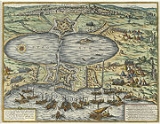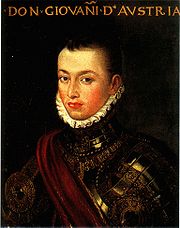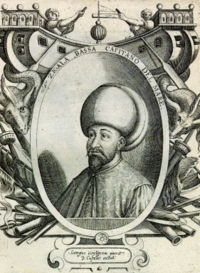
Capture of Tunis
Encyclopedia
The Conquest of Tunis in 1574 marked the final conquest of Tunis
by the Ottoman Empire
over the Spanish Empire
. This was an event of great significance as it decided that North Africa
would be under Muslim rather than Christian rule, ended the Spanish Conquista of Northern Africa started under Isabella I of Castile
and Ferdinand II of Aragon
. The capture of Tunis in 1574 "sealed the Ottoman domination of the eastern and central Maghrib
".
. However, but the Holy Roman Emperor
Charles V
had recaptured it in the Conquest of Tunis
in 1535. He established a garrison and a vassal ruler in the person of the Hafsid dynasty
ruler Al-Hasan. The Bey of Algiers
Uluj Ali
Pasha captured Tunis in 1569 for the Ottoman Empire, but in the aftermath of the 1571 Christian victory at the Battle of Lepanto
, John of Austria managed to take Tunis in October 1573.
and Charles IX of France
, through his pro-Huguenot
ambassador François de Noailles
, Bishop of Dax, tried to obtain the support of the Ottoman ruler Selim II
in order to open a new front against the Spanish king Philip II
. Selim II sent his support through a messenger, who endeavoured to put the Dutch in contact with the rebellious Moriscos of Spain and the pirates of Algiers. Selim also sent a great fleet to attack Tunis
in the Autumn of 1574, thus succeeding in reducing Spanish pressure on the Dutch.
In the Battle of La Goleta, Selim II mustered a fleet of between 250 and 300 warships, with about 75,000 men. The Ottoman fleet was commanded by Sinān Pasha
and Alūj Ali. The Ottoman fleet combined with troops sent by the governors of Algiers
, Tripoli
and Tunis
, for a combined strength of about 100,000. The army attacked Tunis and La Goleta, the presidio of La Goleta, defended by 7,000 men, falling on 24 August 1574. The last Christian troops in a small fort opposite Tunis surrendered on 3 September 1574.

 John of Austria attempted to relieve the siege with a fleet of galleys from Naples
John of Austria attempted to relieve the siege with a fleet of galleys from Naples
and Sicily
but failed due to storms. The Spanish crown, being heavily involved in the Netherlands and short of funds was unable to help significantly.
Cervantes
participated to these events as a soldier, and was among the troops of Don Juan of Austria which tried to rescue the city. He claims that the Ottomans led 22 assaults against the fort of Tunis, losing 25,000 men, while only 300 Christians survived. He wrote about the battle:
Abd al-Malik
, the future Moroccan King, participated to the 1574 conquest of Tunis on the side of the Ottomans.
Gabrio Cervellón was the commander of the fort of Tunis. The general of La Goleta, Don Pedro Portocarerro was taken as a captive to Constantinople
, but died on its way. The captured soldiers were employed as slaves on galleys.
 The battle marked the final establishment of Ottoman rule in Tunis, putting an end to the Hafsid dynasty
The battle marked the final establishment of Ottoman rule in Tunis, putting an end to the Hafsid dynasty
and the Spanish presence in Tunis.
The success of the Turks in the battle of Goleta managed in reducing Spanish pressure on the Dutch, and leading to negotiations at the Conference of Breda. After the death of Charles IX in May 1574 however, contacts weakened, although the Ottomans are said to have supported the 1575-1576 revolt, and establish a Consulate in Antwerp (De Griekse Natie). The Ottomans made a truce with Spain, and shifted their attention to their conflict with Persia in the Ottoman–Safavid War (1578–1590)
. The Spanish crown fell into bankruptcy
on 1 September 1575.
Tunis
Tunis is the capital of both the Tunisian Republic and the Tunis Governorate. It is Tunisia's largest city, with a population of 728,453 as of 2004; the greater metropolitan area holds some 2,412,500 inhabitants....
by the Ottoman Empire
Ottoman Empire
The Ottoman EmpireIt was usually referred to as the "Ottoman Empire", the "Turkish Empire", the "Ottoman Caliphate" or more commonly "Turkey" by its contemporaries...
over the Spanish Empire
Spanish Empire
The Spanish Empire comprised territories and colonies administered directly by Spain in Europe, in America, Africa, Asia and Oceania. It originated during the Age of Exploration and was therefore one of the first global empires. At the time of Habsburgs, Spain reached the peak of its world power....
. This was an event of great significance as it decided that North Africa
North Africa
North Africa or Northern Africa is the northernmost region of the African continent, linked by the Sahara to Sub-Saharan Africa. Geopolitically, the United Nations definition of Northern Africa includes eight countries or territories; Algeria, Egypt, Libya, Morocco, South Sudan, Sudan, Tunisia, and...
would be under Muslim rather than Christian rule, ended the Spanish Conquista of Northern Africa started under Isabella I of Castile
Isabella I of Castile
Isabella I was Queen of Castile and León. She and her husband Ferdinand II of Aragon brought stability to both kingdoms that became the basis for the unification of Spain. Later the two laid the foundations for the political unification of Spain under their grandson, Charles V, Holy Roman Emperor...
and Ferdinand II of Aragon
Ferdinand II of Aragon
Ferdinand the Catholic was King of Aragon , Sicily , Naples , Valencia, Sardinia, and Navarre, Count of Barcelona, jure uxoris King of Castile and then regent of that country also from 1508 to his death, in the name of...
. The capture of Tunis in 1574 "sealed the Ottoman domination of the eastern and central Maghrib
Maghreb
The Maghreb is the region of Northwest Africa, west of Egypt. It includes five countries: Morocco, Algeria, Tunisia, Libya, and Mauritania and the disputed territory of Western Sahara...
".
Background
Tunis had initially been conquered by the Ottomans under Hayreddin Barbarossa in the Conquest of Tunis (1534)Conquest of Tunis (1534)
The conquest of Tunis occurred on 16 August 1534 when Hayreddin Barbarossa captured the city from the Hafsid ruler Muley Hasan.In 1533, Suleiman ordered Hayreddin Barbarossa, whom he had summoned from Algiers, to build a large war fleet in the arsenal of Constantinople...
. However, but the Holy Roman Emperor
Holy Roman Emperor
The Holy Roman Emperor is a term used by historians to denote a medieval ruler who, as German King, had also received the title of "Emperor of the Romans" from the Pope...
Charles V
Charles V, Holy Roman Emperor
Charles V was ruler of the Holy Roman Empire from 1519 and, as Charles I, of the Spanish Empire from 1516 until his voluntary retirement and abdication in favor of his younger brother Ferdinand I and his son Philip II in 1556.As...
had recaptured it in the Conquest of Tunis
Conquest of Tunis
The Conquest of Tunis in 1535 was an attack on Tunis, then under the control of the Ottoman Empire, by the Spanish Empire.-Background:In 1533, Suleiman ordered Hayreddin Barbarossa, whom he had summoned from Algiers, to build a large war fleet in the arsenal of Constantinople...
in 1535. He established a garrison and a vassal ruler in the person of the Hafsid dynasty
Hafsid dynasty
The Hafsids were a Berber dynasty ruling Ifriqiya from 1229 to 1574. Their territories were stretched from east of modern Algeria to west of modern Libya during their zenith.-History:...
ruler Al-Hasan. The Bey of Algiers
Algiers
' is the capital and largest city of Algeria. According to the 1998 census, the population of the city proper was 1,519,570 and that of the urban agglomeration was 2,135,630. In 2009, the population was about 3,500,000...
Uluj Ali
Uluj Ali
Uluj Ali was an Italian by birth who converted to Islam, became a pirate, and later became an Ottoman admiral and Grand Admiral of the Ottoman Fleet in the 16th century.He was also known by several other names in...
Pasha captured Tunis in 1569 for the Ottoman Empire, but in the aftermath of the 1571 Christian victory at the Battle of Lepanto
Battle of Lepanto (1571)
The Battle of Lepanto took place on 7 October 1571 when a fleet of the Holy League, a coalition of Catholic maritime states, decisively defeated the main fleet of the Ottoman Empire in five hours of fighting on the northern edge of the Gulf of Patras, off western Greece...
, John of Austria managed to take Tunis in October 1573.
Capture of Tunis
In 1574, William of OrangeWilliam the Silent
William I, Prince of Orange , also widely known as William the Silent , or simply William of Orange , was the main leader of the Dutch revolt against the Spanish that set off the Eighty Years' War and resulted in the formal independence of the United Provinces in 1648. He was born in the House of...
and Charles IX of France
Charles IX of France
Charles IX was King of France, ruling from 1560 until his death. His reign was dominated by the Wars of Religion. He is best known as king at the time of the St. Bartholomew's Day Massacre.-Childhood:...
, through his pro-Huguenot
Huguenot
The Huguenots were members of the Protestant Reformed Church of France during the 16th and 17th centuries. Since the 17th century, people who formerly would have been called Huguenots have instead simply been called French Protestants, a title suggested by their German co-religionists, the...
ambassador François de Noailles
François de Noailles
François de Noailles, Papal Prothonotary, made Bishop of Dax in 1556, was French ambassador in Venice in the 1560s, and French ambassador of Charles IX to the Ottoman Empire from 1571 to 1575....
, Bishop of Dax, tried to obtain the support of the Ottoman ruler Selim II
Selim II
Selim II Sarkhosh Hashoink , also known as "Selim the Sot " or "Selim the Drunkard"; and as "Sarı Selim" or "Selim the Blond", was the Sultan of the Ottoman Empire from 1566 until his death in 1574.-Early years:He was born in Constantinople a son of Suleiman the...
in order to open a new front against the Spanish king Philip II
Philip II of Spain
Philip II was King of Spain, Portugal, Naples, Sicily, and, while married to Mary I, King of England and Ireland. He was lord of the Seventeen Provinces from 1556 until 1581, holding various titles for the individual territories such as duke or count....
. Selim II sent his support through a messenger, who endeavoured to put the Dutch in contact with the rebellious Moriscos of Spain and the pirates of Algiers. Selim also sent a great fleet to attack Tunis
Tunis
Tunis is the capital of both the Tunisian Republic and the Tunis Governorate. It is Tunisia's largest city, with a population of 728,453 as of 2004; the greater metropolitan area holds some 2,412,500 inhabitants....
in the Autumn of 1574, thus succeeding in reducing Spanish pressure on the Dutch.
In the Battle of La Goleta, Selim II mustered a fleet of between 250 and 300 warships, with about 75,000 men. The Ottoman fleet was commanded by Sinān Pasha
Sinan Pasha
Sinan Pasha or Sinan Pashë Kahremanliu was an Albanian Grand Vizier, Ottoman military commander and statesman.-Life:...
and Alūj Ali. The Ottoman fleet combined with troops sent by the governors of Algiers
Algiers
' is the capital and largest city of Algeria. According to the 1998 census, the population of the city proper was 1,519,570 and that of the urban agglomeration was 2,135,630. In 2009, the population was about 3,500,000...
, Tripoli
Tripoli
Tripoli is the capital and largest city in Libya. It is also known as Western Tripoli , to distinguish it from Tripoli, Lebanon. It is affectionately called The Mermaid of the Mediterranean , describing its turquoise waters and its whitewashed buildings. Tripoli is a Greek name that means "Three...
and Tunis
Tunis
Tunis is the capital of both the Tunisian Republic and the Tunis Governorate. It is Tunisia's largest city, with a population of 728,453 as of 2004; the greater metropolitan area holds some 2,412,500 inhabitants....
, for a combined strength of about 100,000. The army attacked Tunis and La Goleta, the presidio of La Goleta, defended by 7,000 men, falling on 24 August 1574. The last Christian troops in a small fort opposite Tunis surrendered on 3 September 1574.


Naples
Naples is a city in Southern Italy, situated on the country's west coast by the Gulf of Naples. Lying between two notable volcanic regions, Mount Vesuvius and the Phlegraean Fields, it is the capital of the region of Campania and of the province of Naples...
and Sicily
Sicily
Sicily is a region of Italy, and is the largest island in the Mediterranean Sea. Along with the surrounding minor islands, it constitutes an autonomous region of Italy, the Regione Autonoma Siciliana Sicily has a rich and unique culture, especially with regard to the arts, music, literature,...
but failed due to storms. The Spanish crown, being heavily involved in the Netherlands and short of funds was unable to help significantly.
Cervantes
Cervantes
-People:*Alfonso J. Cervantes , mayor of St. Louis, Missouri*Francisco Cervantes de Salazar, 16th-century man of letters*Ignacio Cervantes, Cuban composer*Jorge Cervantes, a world-renowned expert on indoor, outdoor, and greenhouse cannabis cultivation...
participated to these events as a soldier, and was among the troops of Don Juan of Austria which tried to rescue the city. He claims that the Ottomans led 22 assaults against the fort of Tunis, losing 25,000 men, while only 300 Christians survived. He wrote about the battle:
Abd al-Malik
Abu Marwan Abd al-Malik I Saadi
Abu Marwan Abd al-Malik I , often simply Abd al-Malik or Mulay Abdelmalek, was the Saadi Sultan of Morocco from 1576 until his death right after the Battle of Ksar El Kebir against Portugal in 1578.-Saadi Prince:...
, the future Moroccan King, participated to the 1574 conquest of Tunis on the side of the Ottomans.
Gabrio Cervellón was the commander of the fort of Tunis. The general of La Goleta, Don Pedro Portocarerro was taken as a captive to Constantinople
Constantinople
Constantinople was the capital of the Roman, Eastern Roman, Byzantine, Latin, and Ottoman Empires. Throughout most of the Middle Ages, Constantinople was Europe's largest and wealthiest city.-Names:...
, but died on its way. The captured soldiers were employed as slaves on galleys.

Hafsid dynasty
The Hafsids were a Berber dynasty ruling Ifriqiya from 1229 to 1574. Their territories were stretched from east of modern Algeria to west of modern Libya during their zenith.-History:...
and the Spanish presence in Tunis.
The success of the Turks in the battle of Goleta managed in reducing Spanish pressure on the Dutch, and leading to negotiations at the Conference of Breda. After the death of Charles IX in May 1574 however, contacts weakened, although the Ottomans are said to have supported the 1575-1576 revolt, and establish a Consulate in Antwerp (De Griekse Natie). The Ottomans made a truce with Spain, and shifted their attention to their conflict with Persia in the Ottoman–Safavid War (1578–1590)
Ottoman–Safavid War (1578–1590)
The Ottoman–Safavid War was a war between Safavid Persia under Mohammed Khodabanda and later Abbas I, and the Ottoman Empire under Murad III. It began in 1577-1578 and ended in 1590....
. The Spanish crown fell into bankruptcy
Bankruptcy
Bankruptcy is a legal status of an insolvent person or an organisation, that is, one that cannot repay the debts owed to creditors. In most jurisdictions bankruptcy is imposed by a court order, often initiated by the debtor....
on 1 September 1575.

